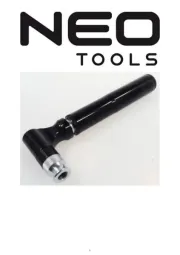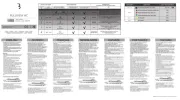Shimano PD-M9000 Handleiding
Shimano
Fietsaccessoire
PD-M9000
Bekijk gratis de handleiding van Shimano PD-M9000 (1 pagina’s), behorend tot de categorie Fietsaccessoire. Deze gids werd als nuttig beoordeeld door 18 mensen en kreeg gemiddeld 4.5 sterren uit 9.5 reviews. Heb je een vraag over Shimano PD-M9000 of wil je andere gebruikers van dit product iets vragen? Stel een vraag
Pagina 1/1

One Holland, Irvine, California 92618, U.S.A. Phone: +1-949-951-5003
High Tech Campus 92, 5656 AG Eindhoven, The Netherlands Phone: +31-402-612222
3-77 Oimatsu-cho, Sakai-ku, Sakai-shi, Osaka 590-8577, Japan
Please note: specifi cations are subject to change for improvement without notice. (English)
© May 2018 by Shimano Inc. ITP
UM-46X0A-001-00 User's manual
SPD Pedals
User's manuals in other languages are available at :
http://si.shimano.com
IMPORTANT NOTICE
•Contact the place of purchase or a bicycle dealer for information on installation and
adjustment of the products which are not found in the user's manual. A dealer's
manual for professional and experienced bicycle mechanics is available on our website
(http://si.shimano.com).
•Do not disassemble or alter this product.
For safety, be sure to read this user's manual thoroughly before use,
and follow them for correct use.
Important Safety Information
Guidelines that require replacement, contact the place of purchase or a
bicycle dealer.
WARNING TO PARENT / GUARDIAN
•USE OF THIS PRODUCT IN ACCORDANCE WITH THESE USER'S MANUALS IS ESSENTIAL
FOR YOUR CHILD'S SAFETY. MAKE SURE YOU AND YOUR CHILD UNDERSTAND THESE
USER'S MANUALS. FAILURE TO FOLLOW THESE USER'S MANUALS MAY RESULT IN
SERIOUS PERSONAL INJURY.
WARNING
•These pedals are designed so that you release them only when you intend to release.
They are not designed to release automatically at times such as when falling off the
bicycle.
•Use only SPD shoes with this product. Other types of shoes may not release from the
pedals, or may release unexpectedly.
•Use only Shimano cleats (SM-SH51 / SM-SH56) and tighten the mounting bolts securely
to the shoes.
•Before attempting to ride with these pedals and shoes, make sure you understand the
operation of the engagement / release mechanism for the pedals and cleats (shoes).
•Before you attempt to ride with these pedals and shoes, apply the brakes, then place
one foot on the ground and practice engaging and releasing each shoe from its pedal
until you can do so naturally and with minimal effort.
•Ride on level ground fi rst until you become adept at engaging and releasing your
shoes from the pedals.
•Before riding, adjust the spring tension of the pedals to your liking.
If the spring tension of the pedals is low, the cleats may become accidentally released
and you may lose balance and fall off the bicycle. If the spring tension of the pedals is
high, the cleats cannot be easily released.
•When riding at low speed or when there is a possibility that you might need to stop
riding, (for example, when doing a U-turn, nearing an intersection, riding uphill or
turning a blind curve), release your shoes from the pedal beforehand so that you can
quickly put your feet onto the ground at any time.
•Use a lighter spring tension for attaching the pedal cleats when riding in adverse
conditions.
•Keep cleats and bindings clear of dirt and debris to ensure engagement and release.
•Remember to check the cleats periodically for wear. When the cleats are worn, replace
them. Always check the spring tension after replacing the pedal cleats and before
riding.
BE SURE TO READ AND FOLLOW THE ABOVE WARNINGS CAREFULLY.
If the warnings are not followed, your shoes may not come out of the pedals when
you intend or they may come out unexpectedly or accidentally, and severe injury
may result.
•Refl ectors have to be mounted to the bike at any time as soon as traveling on public
roads.
•Optional refl ectors are available for models that do not come equipped with refl ectors
as standard. For information on suitable refl ectors, contact the place of purchase or a
bicycle dealer.
•Do not continue riding the bicycle if the refl ectors are dirty or damaged, otherwise it
becomes more diffi cult for oncoming vehicles to see you.
•After reading the user's manual carefully, keep it in a safe place for later reference.
Note
•In addition, if pedaling performance does not feel normal, check this once more.
•If you experience any trouble with the rotating parts of the pedal, the pedal may
require adjustment. Contact the place of purchase or a bicycle dealer.
•Parts are not guaranteed against natural wear or deterioration resulting from normal
use.
•For maximum performance we highly recommend Shimano lubricants and
maintenance products.
Regular inspections before riding the bicycle
Before riding the bicycle, check the following items. If any problems are found with the
following items, contact the place of purchase or a bicycle dealer.
•Are the fastening sections fi xed securely?
•Is there a large play between the cleats and the pedals because of wear?
•Are there any abnormalities in the engagement and release of the cleats?
•Are there any abnormal noises?
Names of parts
Fastening
section
Binding
Cleat types and using the pedals
WARNING
Do not use the pedals and cleats in any way other than as
described in these user's manuals. The cleats are designed
to engage and release from the pedals when the cleats and
pedals are facing forward.
See below for instructions on how to install the cleats.
FAILURE TO FOLLOW THESE INSTRUCTIONS MAY RESULT IN
SERIOUS PERSONAL INJURY.
Front
Single release mode cleats (SM-SH51) and multiple release mode cleats (SM-SH56) are
available for use with these pedals.
Each type of cleat has its own distinctive features, so be sure to read the Service
Instructions carefully and select whichever type of cleat best suits your riding style
and the terrain and riding conditions which you will encounter.
Other types of cleats such as single release mode cleats (SM-SH52) and multiple
release mode cleats (SM-SH55) cannot be used, as they do not provide stable enough
step-out performance or suffi cient holding force.
Engaging the cleats with the pedals
Press the cleats into the pedals with a forward
and downward motion.
Releasing the cleats from the pedals
The method of release varies according to the type of cleats you are using.
(Check the model number and color of your cleats to determine the proper method
of release.)
Single release mode cleats:
SM-SH51
(black)
Multiple release mode cleats:
SM-SH56
(silver, gold / Optional accessory)
These cleats only release when the
heel is twisted . outward
They will not release if the heel is
twisted in any other direction.
The cleats can be released by twisting
your heel in any direction.
You are able to apply upward force to
the pedal, since they will not release
unless the foot is twisted outward.
Because the cleats can also be released
by lifting your heel, they may become
accidentally released when applying
upward force on the pedals.
These cleats should not be used for
riding style which may involve pulling
up on the pedals or for activities, such
as jumping, in which pulling forces are
applied to the pedals causing possible
release from the pedals.
The cleats will not necessarily release if
you lose your balance.
Accordingly, for places and conditions
where it looks as though you may lose
balance, make sure that you have
suffi cient time to release the cleats
beforehand.
Although the cleats can be released by
twisting your heels in any direction or
by lifting, they will not necessarily
release if you lose your balance.
Accordingly, for places and conditions
where it looks as though you may lose
balance, make sure that you have
suffi cient time to release the cleats
beforehand.
When you are pedaling vigorously,
your heel may inadvertently twist
outward and this may cause the cleat
to release accidentally. If the cleat
releases by accident, you may fall off
the bicycle and serious injury may
result.
You can help to prevent this by
adjusting the amount of force required
to release the cleats, and you should
practice until you are accustomed to
the amount of force and the angle
required to release the cleats.
If the cleats release by accident, you
may fall off the bicycle and serious
injury may result.
If the features of multiple release
mode cleats are not suffi ciently
understood and if they are not used
correctly, then they may release
accidentally with a greater frequency
than for single release mode cleats.
You can help to prevent this by
adjusting the amount of force required
to release the cleats in any direction,
and you should practice until you are
accustomed to the amount of force
and the angle required to release.
Note:
It is necessary to practice releasing until you become accustomed to the
technique.
* In multiple release mode, releasing by lifting your heel requires particular
practice.
Adjusting the spring tension of the pedals
Adjustment bolt
Adjustment bolt
Decrease
Increase
1
1
2
2
2.5 mm hexagon wrench /
3 mm hexagon wrench
Adjustment plate
•The spring tension of the pedals can be adjusted by turning the adjustment bolt to
adjust the spring force of the binding.
•One click of the adjustment bolt changes one step. There are four clicks per turn.
•The adjustment bolt is located at the rear of each binding, at four positions in total of
both pedals.
•Adjust the spring force to the optimum cleat holding force when releasing the cleats
from the bindings.
•Equalize the cleat holding forces at four positions by checking the adjustment plate
position and counting the number of turns of the adjustment bolts.
•Turning the adjustment bolt clockwise increases the spring tension, and turning it
anti-clockwise reduces the spring tension.
Strongest position Weakest position
Adjustment
plate
Adjustment
bolt
If the adjustment plate is at the strongest or the weakest position, do not turn
the adjustment bolt any further.
Note:
•In order to prevent accidental or unintentional release from occurring, make sure
all the spring tensions are properly adjusted and check the spring tensions.
•If the spring tensions are not adjusted equally, it can cause the rider diffi culty to
engage or release from the pedals. The spring tensions should be adjusted equally
for both right and left pedals.
Replacement of the cleats and body cover
The cleats and body cover are consumables and need to be replaced periodically.
The cleats and body cover should be replaced at a dealer or an agency as soon as possible
after they become worn and diffi cult to release or can be released with much less effort
than that required when they were new.
Body cover
Product specificaties
| Merk: | Shimano |
| Categorie: | Fietsaccessoire |
| Model: | PD-M9000 |
Heb je hulp nodig?
Als je hulp nodig hebt met Shimano PD-M9000 stel dan hieronder een vraag en andere gebruikers zullen je antwoorden
Handleiding Fietsaccessoire Shimano

15 November 2024

15 November 2024

12 Juni 2023

9 Juni 2023

8 Juni 2023

6 Juni 2023

4 Juni 2023

23 Mei 2023

22 Mei 2023

21 Mei 2023
Handleiding Fietsaccessoire
- Master Lock
- Cecotec
- Ergon
- Funn
- Nedis
- Tacx
- NEO Tools
- Trelock
- Polisport
- Fiamma
- Evoc
- SECURITY Plus
- MOTO
- Topeak
- KLICKfix
Nieuwste handleidingen voor Fietsaccessoire

4 Augustus 2025

14 Juli 2025

14 Juli 2025

14 Juli 2025

4 Juli 2025

4 Juli 2025

4 Juli 2025

4 Juli 2025

4 Juli 2025

3 Juli 2025